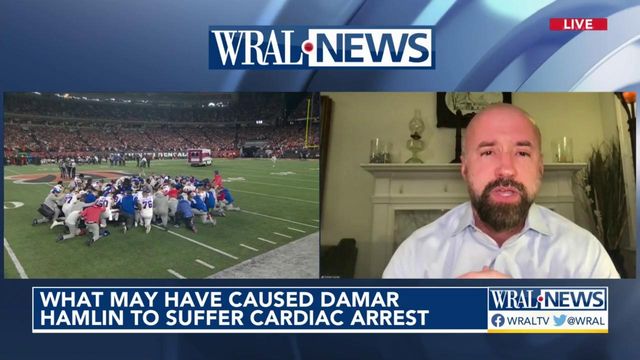'It's a very rare occurrence': Triangle doctors provide perspective on what happened to Bills player Damar Hamlin
Damar Hamlin's cardiac arrest was a frightening scene. WRAL News spoke with Dr. Manesh Patel of Duke Medicine and Dr. Robert Lee Jobe of UNC Health to discuss what happened to Hamlin and what his prognosis is going forward.
Posted — UpdatedDoctors in the Triangle are providing an opinion on what happened to Buffalo Bills safety Damar Hamlin on Monday Night Football.
For Dr. Manesh Patel, chief of cardiology at Duke Medicine, it was an unnerving scene.
"It's traumatizing and it's scary," Patel said.
While Patel couldn't say for sure what happened to Hamlin, he speculates Hamlin took a blow to the chest at the exact wrong time in the cardiac cycle.
"It's possible you can get a trauma or a reset when the heart is in certain phase of the cycle," Patel said. "It can lead your heart to go into dangerous rhythm of ventricular defibrillation,"
This event is referred to as commotio cordis.
Commotio cordis occurs when your heart sustains trauma during a very specific point of the cardiac cycle. It can result in cardiac arrest and even death without emergency medical care.
"The timing of it has to be such where [it was] in a few milliseconds," Patel said. "A lot of what happened here; its been described and seen in male athletes."
The condition often happens in young baseball players who could take a blow to the chest with a ball or a bat, according to Dr. Robert Lee Jobe with UNC Health.
The cases, however, are few and far between.
"It's a very rare occurrence," Jobe said. "Just a few dozen events have occurred over many years we have been looking at this."
Both doctors agreed that the emergency medical treatment he received, and how fast it happened helped keep him alive.
"The minute someone goes down we start high-quality CPR," Patel said. " So, blood flow goes to the brain and their body while are getting AED there, to get people back to a normal rhythm."
As of Tuesday afternoon, Hamlin still remains hospitalized in critical condition and is under sedation. Patel believes the next few hours will be crucial in his recovery.
"The next 48 to 72 hours will be crucial," Patel said. "We have seen people recover from things like this."
Related Topics
• Credits
Copyright 2024 by Capitol Broadcasting Company. All rights reserved. This material may not be published, broadcast, rewritten or redistributed.






